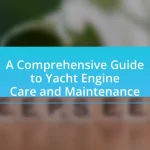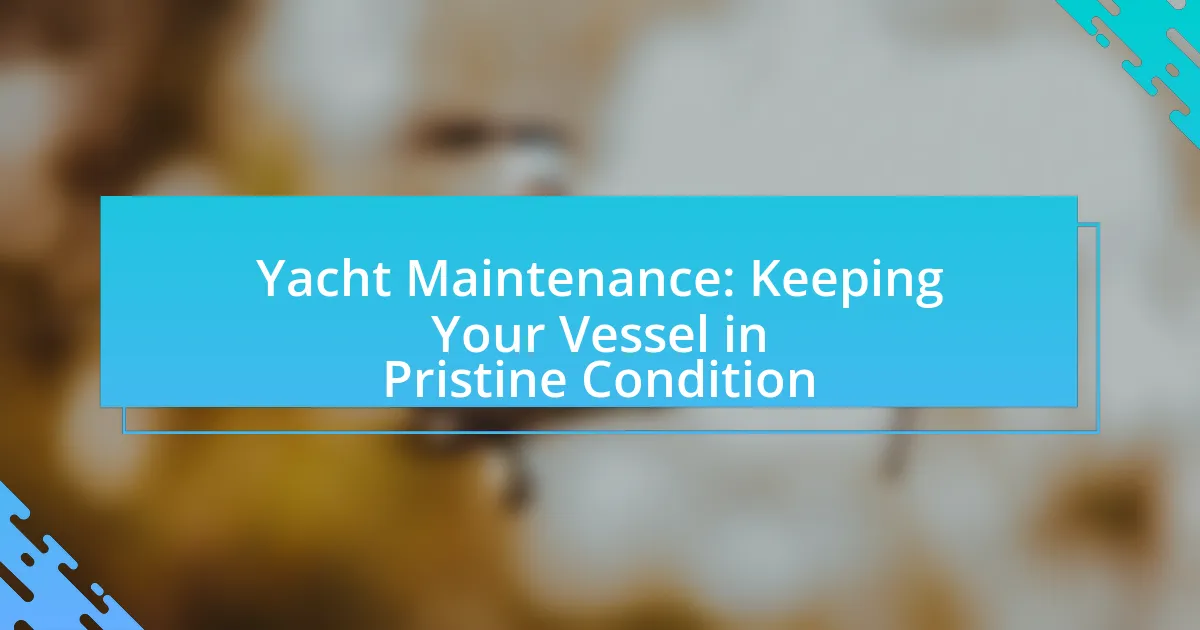Yacht ownership involves the legal possession and responsibility for a yacht, encompassing maintenance, operation, and associated costs such as insurance and docking fees. This guide outlines the distinct financial and regulatory aspects of yacht ownership compared to other asset types, detailing the responsibilities of owners, the impact on lifestyle choices, and the various yacht types available. It also covers the financial implications, including depreciation, budgeting for ownership, and the purchasing process, while emphasizing the importance of compliance with maritime laws and ongoing maintenance. Additionally, the article highlights best practices for yacht management, the benefits of hiring a crew, and tips for new owners to enhance their experience and avoid common pitfalls.

What is Yacht Ownership?
Yacht ownership refers to the legal possession and responsibility for a yacht, which is a type of recreational boat typically used for leisure activities. Owners are accountable for the maintenance, operation, and associated costs of the yacht, including insurance, docking fees, and crew salaries if applicable. According to the National Marine Manufacturers Association, the recreational boating industry in the United States alone contributes over $40 billion annually, highlighting the significance and investment involved in yacht ownership.
How does yacht ownership differ from other types of ownership?
Yacht ownership differs from other types of ownership primarily due to its unique financial, maintenance, and regulatory requirements. Unlike traditional property ownership, yacht owners face significant ongoing costs such as docking fees, insurance, and maintenance, which can exceed the initial purchase price. Additionally, yachts are subject to maritime laws and regulations that vary by jurisdiction, impacting how they can be used and maintained. For instance, the International Maritime Organization sets safety standards that must be adhered to, which is not a concern for typical real estate ownership. This combination of high operational costs and regulatory complexities makes yacht ownership distinct from owning other assets like homes or vehicles.
What are the key responsibilities of a yacht owner?
The key responsibilities of a yacht owner include maintaining the vessel, ensuring compliance with maritime laws, and managing operational costs. Yacht owners must regularly inspect and service their yacht to ensure safety and performance, which includes routine maintenance of engines, hulls, and onboard systems. Compliance with maritime laws involves adhering to regulations regarding registration, safety equipment, and environmental standards, which vary by jurisdiction. Additionally, yacht owners are responsible for budgeting and managing expenses related to docking, insurance, fuel, and crew salaries, which can significantly impact the overall cost of ownership.
How does yacht ownership impact lifestyle choices?
Yacht ownership significantly impacts lifestyle choices by providing unique opportunities for leisure, travel, and social engagement. Owners often prioritize experiences such as sailing, exploring new destinations, and hosting gatherings, which can lead to a more adventurous and social lifestyle. According to a study by the International Council of Marine Industry Associations, yacht owners frequently report increased satisfaction in their personal lives due to the recreational activities and community connections fostered by yacht ownership. This lifestyle shift can also influence spending habits, as owners may invest more in travel-related expenses and luxury goods associated with their maritime activities.
What are the different types of yachts available for ownership?
The different types of yachts available for ownership include sailing yachts, motor yachts, catamarans, and superyachts. Sailing yachts are propelled by sails and are often favored for their traditional appeal and sailing experience. Motor yachts, powered by engines, provide speed and luxury, making them popular for leisure cruising. Catamarans, characterized by their twin hulls, offer stability and spaciousness, ideal for families or groups. Superyachts represent the pinnacle of luxury and size, often exceeding 100 feet in length and featuring extensive amenities. Each type caters to different preferences and uses, ensuring a variety of options for potential owners.
What factors should be considered when choosing a yacht type?
When choosing a yacht type, key factors include intended use, size, budget, and maintenance requirements. Intended use determines whether a yacht is for leisure, racing, or long-distance cruising, influencing design and features. Size affects capacity and maneuverability; larger yachts offer more space but may require more crew and higher costs. Budget considerations encompass purchase price, insurance, and operational expenses, which vary significantly across yacht types. Maintenance requirements differ based on materials and design complexity, impacting long-term ownership costs. These factors collectively guide the decision-making process for prospective yacht owners.
How do different yacht types cater to various activities?
Different yacht types cater to various activities by offering specialized designs and features tailored to specific uses. For instance, sailing yachts are optimized for recreational sailing and racing, providing agility and speed, while motor yachts focus on luxury and comfort, making them ideal for leisurely cruising and entertaining guests. Additionally, catamarans, with their stable dual-hull design, are well-suited for family outings and water sports, as they provide ample deck space and stability. Research indicates that the choice of yacht type significantly influences the activities one can engage in, with motor yachts often equipped with amenities for fishing and diving, while sailing yachts may include rigging for competitive sailing.
Why is yacht ownership a significant investment?
Yacht ownership is a significant investment due to its potential for appreciation in value and the unique lifestyle benefits it offers. Historically, luxury yachts have shown a tendency to retain or increase their value over time, especially if well-maintained and in demand. According to a report by the International Council of Marine Industry Associations, the global yacht market has been growing, with high-end yachts often appreciating by 5-10% annually. Additionally, yacht ownership provides exclusive access to leisure activities, travel opportunities, and social networking, which can enhance personal and business relationships. These factors collectively contribute to the financial and experiential value of owning a yacht.
What are the financial implications of owning a yacht?
Owning a yacht incurs significant financial implications, including purchase costs, maintenance expenses, and operational fees. The initial purchase price of a yacht can range from tens of thousands to millions of dollars, depending on size and luxury features. Annual maintenance costs typically amount to 10% of the yacht’s value, covering repairs, cleaning, and inspections. Additionally, operational expenses such as fuel, docking fees, insurance, and crew salaries can add thousands of dollars each year. For example, a 50-foot yacht may require around $30,000 annually for maintenance and operational costs, highlighting the substantial financial commitment involved in yacht ownership.
How does yacht depreciation affect ownership value?
Yacht depreciation significantly reduces ownership value over time, typically at a rate of 10-15% annually during the first few years. This decline in value affects the resale price, making it crucial for owners to understand that a yacht’s worth diminishes as it ages, influenced by factors such as maintenance, market demand, and technological advancements. For instance, a yacht purchased for $1 million may only be valued at $700,000 after five years, illustrating the financial impact of depreciation on ownership value.

What are the steps to becoming a yacht owner?
To become a yacht owner, one must follow several key steps: first, determine the budget for purchasing and maintaining a yacht, which typically ranges from tens of thousands to millions of dollars depending on the size and type. Next, research different types of yachts, such as sailing yachts or motor yachts, to identify which best suits personal preferences and intended use. After that, engage a yacht broker to assist in finding suitable options and negotiating the purchase. Once a yacht is selected, conduct a thorough inspection and sea trial to ensure it meets expectations. Following a successful inspection, finalize the purchase by completing the necessary paperwork and registration. Lastly, consider hiring a crew or taking sailing courses if needed, to ensure safe and enjoyable operation of the yacht. These steps are essential for a successful transition into yacht ownership.
How do you determine your budget for yacht ownership?
To determine your budget for yacht ownership, assess both the initial purchase price and ongoing costs. The initial purchase price varies significantly based on the yacht’s size, brand, and condition, typically ranging from tens of thousands to millions of dollars. Ongoing costs include maintenance, insurance, docking fees, fuel, and crew salaries, which can amount to 10-20% of the yacht’s value annually. For example, a yacht valued at $1 million may incur $100,000 to $200,000 in annual expenses. Understanding these financial commitments ensures a realistic budget for yacht ownership.
What costs should be included in the yacht ownership budget?
The yacht ownership budget should include acquisition costs, maintenance expenses, operational costs, insurance, and docking fees. Acquisition costs encompass the purchase price of the yacht, which can vary significantly based on size and brand. Maintenance expenses involve routine upkeep, repairs, and servicing, typically estimated at 10% of the yacht’s value annually. Operational costs include fuel, provisions, and crew salaries if applicable, which can fluctuate based on usage. Insurance is essential for protecting the investment and can range from 1% to 3% of the yacht’s value per year. Lastly, docking fees, which vary by location and marina, are necessary for securing a berth. These categories collectively represent the comprehensive financial commitment required for yacht ownership.
How can financing options affect your budget?
Financing options can significantly impact your budget by determining the total cost of ownership and monthly expenses associated with yacht ownership. Different financing methods, such as loans or leases, can influence interest rates, down payments, and repayment terms, which directly affect cash flow and overall affordability. For instance, a loan with a lower interest rate can reduce monthly payments, allowing for a more manageable budget, while a higher rate can strain finances. According to the National Marine Manufacturers Association, the average interest rate for marine loans can range from 4% to 7%, illustrating how financing choices can lead to varying budget implications.
What is the process of purchasing a yacht?
The process of purchasing a yacht involves several key steps: determining your budget, researching yacht types, selecting a broker, viewing yachts, making an offer, conducting surveys, and finalizing the purchase. First, establish a budget that includes not only the purchase price but also ongoing costs such as maintenance, insurance, and docking fees. Next, research different types of yachts to identify which suits your needs, whether it’s a sailboat, motor yacht, or catamaran.
After that, select a reputable yacht broker who can assist you in finding suitable options and negotiating the purchase. Viewing yachts allows you to assess their condition and features. Once you find a yacht you like, you will make an offer, which may involve negotiations. Following an accepted offer, a marine survey is typically conducted to evaluate the yacht’s condition and value. Finally, upon satisfactory survey results, you will finalize the purchase by signing contracts and transferring funds. This structured approach ensures a thorough and informed buying experience.
How do you find the right yacht for your needs?
To find the right yacht for your needs, assess your intended use, budget, and preferences. Start by determining whether you need a yacht for leisure, racing, or long-distance cruising, as this will influence the type and size of the yacht. Next, establish a budget that includes purchase price, maintenance, and operational costs. Research various yacht types, such as sailing yachts, motor yachts, or catamarans, to understand their features and benefits. Additionally, consider factors like the number of passengers, onboard amenities, and storage capacity. Consulting with yacht brokers or attending boat shows can provide valuable insights and options tailored to your requirements.
What role do yacht brokers play in the purchasing process?
Yacht brokers serve as intermediaries in the yacht purchasing process, facilitating transactions between buyers and sellers. They provide expertise in market trends, pricing, and yacht specifications, which helps buyers make informed decisions. Brokers also handle negotiations, ensuring that both parties reach a satisfactory agreement. According to the National Marine Manufacturers Association, utilizing a broker can streamline the buying process, as they often have access to a wider range of listings and can offer insights that may not be readily available to individual buyers.
What legal considerations should be taken into account?
Legal considerations for yacht ownership include compliance with maritime laws, registration requirements, insurance obligations, and adherence to environmental regulations. Maritime laws dictate the rights and responsibilities of yacht owners, including safety standards and liability issues. Registration is necessary to legally operate a yacht, which varies by jurisdiction and often requires documentation of ownership and compliance with local regulations. Insurance is essential to protect against potential damages or liabilities, with policies typically covering hull damage, liability, and personal injury. Environmental regulations mandate adherence to waste disposal and emissions standards to minimize ecological impact. These legal aspects are crucial for ensuring lawful and responsible yacht ownership.
What documentation is required for yacht ownership?
To establish yacht ownership, the required documentation includes a bill of sale, registration documents, and proof of insurance. The bill of sale serves as the primary legal document that transfers ownership from the seller to the buyer, detailing the yacht’s specifications and sale price. Registration documents are necessary to officially register the yacht with the relevant maritime authority, which may vary by country, ensuring compliance with local laws. Proof of insurance is essential to protect the owner against potential liabilities and damages associated with yacht operation. These documents collectively validate ownership and ensure legal compliance in maritime activities.
How do maritime laws affect yacht ownership?
Maritime laws significantly impact yacht ownership by establishing regulations regarding registration, safety standards, and liability. These laws require yacht owners to comply with specific documentation and safety equipment mandates, which vary by jurisdiction. For instance, in the United States, the Coast Guard enforces regulations that dictate the necessary safety gear and operational protocols for recreational vessels. Additionally, maritime laws govern issues such as ownership transfer, taxation, and environmental compliance, ensuring that yacht owners adhere to local and international standards. Failure to comply with these laws can result in penalties, including fines or the seizure of the vessel, highlighting the importance of understanding maritime regulations in yacht ownership.

What are the ongoing responsibilities of yacht ownership?
Ongoing responsibilities of yacht ownership include regular maintenance, insurance management, compliance with maritime regulations, and operational costs. Owners must ensure the yacht is maintained to prevent deterioration, which involves routine inspections, cleaning, and repairs. Insurance management is crucial for protecting the investment, requiring owners to keep policies updated and ensure adequate coverage. Compliance with maritime regulations involves adhering to safety standards, registration requirements, and environmental laws, which vary by location. Additionally, operational costs such as fuel, docking fees, and crew salaries must be budgeted for to ensure the yacht remains functional and enjoyable.
How do you maintain a yacht properly?
To maintain a yacht properly, regular inspections and maintenance of the hull, engine, and onboard systems are essential. This includes cleaning the hull to prevent algae growth, checking for any signs of wear or damage, and ensuring that the engine oil and coolant levels are adequate. Additionally, routine servicing of the electrical systems, navigation equipment, and safety gear is crucial for optimal performance and safety. According to the American Boat and Yacht Council, following a structured maintenance schedule can extend the lifespan of a yacht and enhance its resale value.
What routine maintenance tasks should be performed?
Routine maintenance tasks for yacht ownership include inspecting and cleaning the hull, checking and servicing the engine, maintaining the electrical systems, and ensuring the safety equipment is functional. Regular hull inspections prevent marine growth and damage, while engine servicing, including oil changes and filter replacements, ensures optimal performance. Electrical systems should be checked for corrosion and functionality to avoid failures. Additionally, safety equipment, such as life jackets and fire extinguishers, must be inspected to comply with safety regulations and ensure readiness in emergencies. These tasks are essential for maintaining the yacht’s performance, safety, and longevity.
How can you ensure safety and compliance on your yacht?
To ensure safety and compliance on your yacht, regularly conduct safety drills and maintain up-to-date safety equipment. Implementing a comprehensive safety management system, which includes regular inspections and adherence to maritime regulations, is essential. According to the International Maritime Organization, compliance with safety standards significantly reduces the risk of accidents at sea. Additionally, ensuring that all crew members are trained in emergency procedures and that safety equipment, such as life jackets and fire extinguishers, is easily accessible and functional further enhances safety and compliance.
What are the best practices for yacht management?
The best practices for yacht management include regular maintenance, effective crew management, financial oversight, and compliance with regulations. Regular maintenance ensures the yacht remains in optimal condition, which can prevent costly repairs and enhance safety. Effective crew management involves hiring qualified personnel and providing ongoing training to ensure high standards of service and safety. Financial oversight includes budgeting for operational costs, insurance, and unexpected expenses, which is crucial for sustainable yacht ownership. Compliance with maritime laws and safety regulations is essential to avoid legal issues and ensure the safety of all onboard. These practices are supported by industry standards and guidelines from organizations such as the International Maritime Organization, which emphasizes the importance of safety and maintenance in yacht management.
How can hiring a crew enhance your ownership experience?
Hiring a crew can significantly enhance your ownership experience by providing professional expertise in yacht management, maintenance, and operation. A skilled crew ensures that the yacht is well-maintained, which can prolong its lifespan and preserve its value. Additionally, crew members can offer personalized service, enhancing the overall enjoyment of your time on the water. For instance, according to the International Yacht Brokers Association, yachts with professional crews often have higher resale values due to their maintained condition and the quality of service provided. This combination of maintenance and service leads to a more enjoyable and stress-free ownership experience.
What are the benefits of joining a yacht club or community?
Joining a yacht club or community provides numerous benefits, including access to exclusive facilities, networking opportunities, and organized events. Members often enjoy amenities such as docks, maintenance services, and social spaces that enhance the boating experience. Additionally, yacht clubs facilitate connections with fellow boating enthusiasts, fostering friendships and partnerships that can lead to shared experiences and knowledge. Organized events, such as regattas and social gatherings, offer members the chance to participate in competitive sailing and community-building activities, enriching their overall enjoyment of yachting.
What tips can help new yacht owners succeed?
New yacht owners can succeed by prioritizing education about yacht maintenance and navigation. Understanding the technical aspects of yacht operation, including engine care and safety protocols, is crucial for effective management. According to the American Boat and Yacht Council, regular maintenance can extend the lifespan of a yacht and enhance safety, with proper upkeep reducing the risk of costly repairs by up to 50%. Additionally, joining a yacht club or community can provide valuable networking opportunities and access to experienced mentors, which can further facilitate a smoother ownership experience.
How can you maximize your enjoyment of yacht ownership?
To maximize your enjoyment of yacht ownership, actively engage in regular maintenance and personalized upgrades. Regular maintenance ensures the yacht remains in optimal condition, enhancing safety and performance, while personalized upgrades, such as custom interiors or advanced navigation systems, cater to individual preferences and improve the overall experience. According to the National Marine Manufacturers Association, well-maintained boats retain higher resale values and provide a more enjoyable experience on the water, confirming that investment in upkeep and customization directly correlates with enhanced satisfaction in yacht ownership.
What common pitfalls should new yacht owners avoid?
New yacht owners should avoid underestimating maintenance costs, as these can significantly impact their budget. Many first-time owners fail to account for regular upkeep, repairs, and unexpected expenses, which can average 10% of the yacht’s value annually. Additionally, new owners often overlook the importance of proper training and licensing, which can lead to safety hazards and legal issues. Ignoring insurance needs is another common mistake; adequate coverage is essential to protect against potential damages and liabilities. Lastly, new yacht owners frequently misjudge the time commitment required for ownership, leading to frustration and dissatisfaction.

















